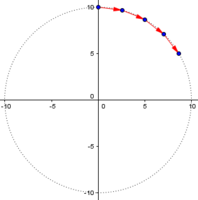BIGNUMSSCAREME
New member
- Joined
- Aug 25, 2020
- Messages
- 5
I don't have a set of problems for this, as its a coding-related issue. I was just wondering if I graphed a circle, and wanted to find a point that was 2 total units away in a specific direction (meaning one way around the circle), how would I go about doing this? By 2 total units I mean 1 unit in the x direction, one in the y, OR 1.5 in the x, 0.5 in the y, or any other combination that results in a 2 when their absolute values are added.


